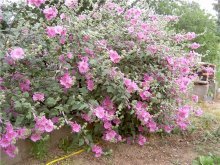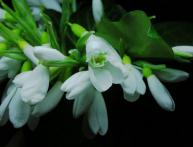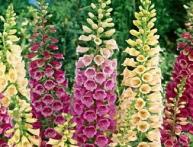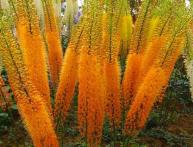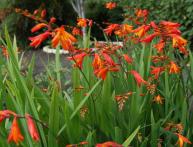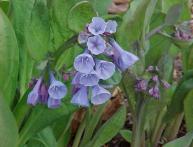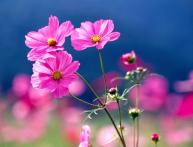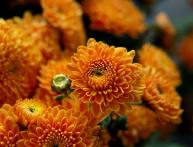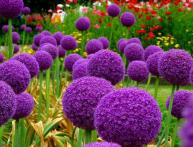Lavatera flowers - a flowerbed without hassle
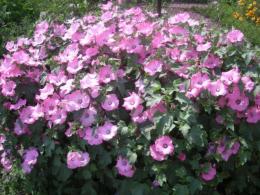
Lavatera, a plant from the malvaceae family, is popularly known as khatma. Once quite a popular, and subsequently undeservedly forgotten plant, today Lavatera is experiencing a new surge of interest from gardeners and summer residents. Firstly, this is due to the minimal cost of caring for the plant and its unpretentiousness, and secondly, lavatera flowers are very beautiful and diverse in appearance.
In addition to the riot of color that many varieties of lavatera demonstrate, it also differs in the height of its stems, which allows it to be used both in the garden and in indoor plant growing.
Content:
Healing properties of lavatera
Lavatera was first described by the Swiss naturalists and healers of the 17th century, the Lavater brothers, after whose surname these flowers were named. Initially, Lavatera naturalists discovered wild varieties of the plant. As the years passed, Lavatera was discovered on every continent. Using traditional medicine in their medical practice, the Lavaters discovered the healing properties of this plant.
IN pharmaceutical industry Lavatera Thuringiensis is especially prized. Therefore, among the variety of varieties, Lavatera or, as it is also called, Thuringian Hatma, you should definitely plant it in your garden plot:
- Lavatera leaves are rich in vitamin C and have often been used to treat ringworm.
- A decoction of lavatera roots can heal lung diseases and alleviate cold symptoms, and also successfully treats diseases of the gastrointestinal tract. Also, various skin lesions are treated with infusion of the roots.
- An ointment prepared using dry lavatera leaves was used in the treatment of rheumatism and neuralgia.
- Lavatera leaves and flowers are harvested during the flowering period of the plant, because during this period they contain the maximum concentration of alkaloids and flavonoids.
- The roots are harvested after the lavatera has finished flowering, usually in the fall.
Having Thuringian Lavatera in their flower garden, gardeners acquire not only a plant that blooms beautifully all summer, but also an irreplaceable healer for many ailments.
Features of growth and care
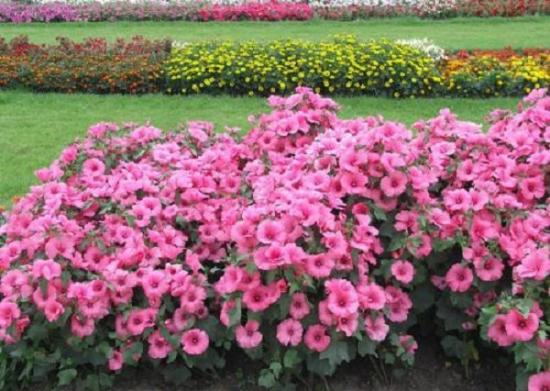
Initially, Africa and Europe were considered the homeland of lavatera, but subsequently it was discovered on all continents and in almost all latitudes. Due to their prevalence, selected Lavatera varieties are very unpretentious both to climatic conditions and to the choice of soil.
Lavatera grows in any soil, loves loose soil structure. For a more saturated color of the inflorescences, you can periodically fertilize the soil and fertilize, but this will not require frequent actions; usually experienced gardeners do this before flowering and at the moment of flowering, when the buds form. In addition, lavatera grows equally well in both shaded and sunny areas.
The plant also does not require frequent watering; it is enough to water the flower as the soil dries out or once every seven days, which is convenient for people who go to the country only on weekends.Lavatera is completely immune to the vagaries of the weather, but due to the height of the plants, it is better to tie the stems so that they are not broken by strong winds.
Lavatera blooms in almost any weather, even at temperatures below 15 degrees Celsius. Lavatera is also unique in that it has strong immunity to many pests and diseases. The only disease that can damage a flower is rust. When a plant is infected with this disease, dark spots form on the leaves. In this case, the leaves are removed.
In case of severe damage, the entire plant should be removed. Also, flowers that have already finished blooming should be removed, because... the mucus formed during rotting can cause burns to the leaves.
Simple care for lavatera will not cause much trouble even for novice gardeners and summer residents, and the variety of varieties will allow you to create a unique flowerbed design.
Lavatera varieties
Lavatera represents a lush bushy plant with many large bell-shaped flowers. As a result of the work of breeders, the main types of lavatera are annual, biennial and perennial plant varieties. And although there are more than 20 types of lavatera varieties in our time, it is worth considering some of the most interesting of them:
- Novella: for lavatera it is a very low plant, only about 20 cm. The flowers are large, pink, this variety of lavatera begins to bloom early. Also well suited for indoor plant growing. Planted on the site can grow up to 60 cm.
- Bayt Sherub: produces low shoots, up to 35 cm in height. The flowers are white and large. Suitable for both indoor and garden floriculture.
- Mont Blanc: Grows up to 60 cm in height. The flowers are bright white, with well-defined veins.
- Pink Beauty: grows up to 60 cm. Has soft pink flowers with dark, well-defined veins.
- Silver Cap: grows up to 70 cm in height. It blooms with bright pink flowers with burgundy veins.
- Mix of colors: produces stems 60-80 cm in height. The flowers are large, up to 10 cm in diameter, white, pink and dark pink.
- Lavatera ruby: an annual variety that produces a plant 1 m high. It is distinguished by flowers of soft ruby shades.
- Silk and cashmere: grows up to 80 cm, characterized by flowers of rich scarlet shades.
- garden rose: reaches a height of 1 m. It blooms with both white and pink flowers, there are also white flowers with dark pink veins. It is interesting because it grows quite quickly.
- Lovelyness: Grows slightly taller than Silver Cap, up to only 75cm tall. It also blooms with bright pink flowers with burgundy, well-defined veins.
- Lavatera Thuringiensis: produces tall stems, up to 2 m in height. It blooms with beautiful pink flowers with individual heart-shaped petals.
Building a flower bed
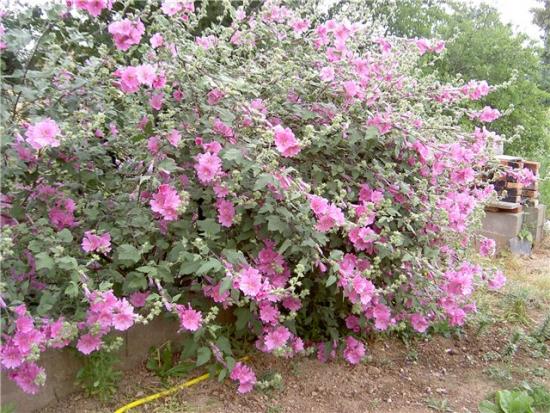
For spring planting of seedlings, it is necessary to begin germinating lavatera seeds in March-April in order to be able to plant them in the ground in May. Tk. The plant is resilient and frost-resistant, so you don’t have to worry about early planting. The sprouts should be planted at a distance of 20-30 cm from each other, after watering and fertilizing the soil with phosphate-potassium fertilizers.
While the plants have not yet grown enough, they need to be weeded periodically. In the future, this is not necessary, because Lavatera will “clog” any weed.
Choosing required varieties From the variety offered in stores, you can create a unique flower garden on your site.For example, you can create an imitation of a slide by varying the varieties of lavatera in height. For example, you can plant lavatera varieties, ranging from the smallest to the giant varieties.
This may first be the Mont Blanc variety, next next to it you can plant the Mixture of Colors variety, then the Ruby Lavatera or Garden Rose, and, of course, the Thuringian Lavatera variety because of its medicinal properties.
By choosing colors when planting lavatera, you can pleasantly please the eye with a riot of color in your garden plot. For example, you can mix seedlings of the varieties “Mont Blanc”, “Silver Cup”, “Mixture of Colors” and “Silk and Cashmere”, all of these varieties are approximately the same in height, but very diverse in color.
For beginners or just very busy gardeners, Lavatera, represented by a wide variety of its colors and sizes, is an indispensable plant that allows you to create a beautiful flower bed or add new flowers to an existing flower garden without any extra effort.
Watch how to combine lavatera and lawn grass in the video:
Interesting information about the vegetable garden


